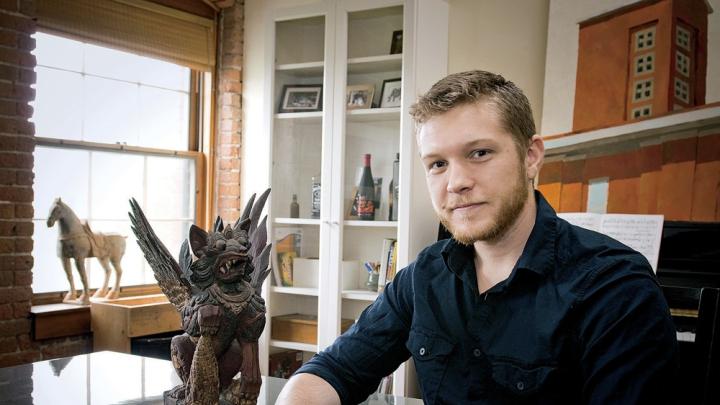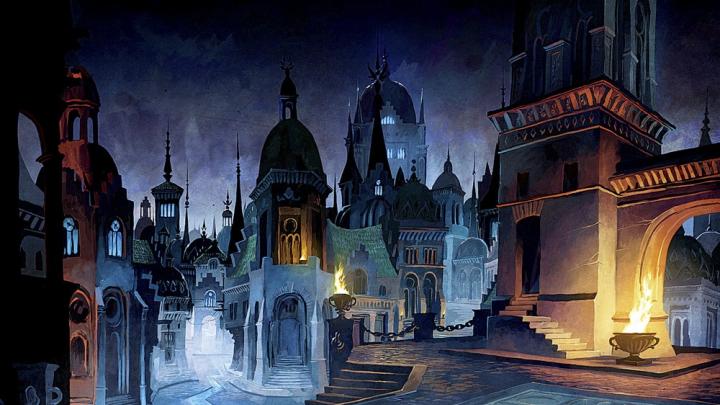When he lays down cobblestone roads, spends hours on the windows of a home on a quiet alleyway, or puts the final architectural details on a towering church spire, Scott Duquette ’05 thinks of the visitors who will someday come to his city. They should remember his creation the way they look back fondly on a foreign city they once toured, with nostalgia for the buildings, the people, the feel of it all.
Why should it matter that the city isn’t real?
Duquette is a video-game artist, a designer who created worlds for 38 Studios, the Providence, Rhode Island, company founded by former Boston Red Sox pitcher Curt Schilling. (On June 7, the financially ailing firm filed for Chapter 7 bankruptcy, clearing the way for its liquidation.) Duquette has spent the past five years using design software and his concentration in visual and environmental studies to realize the imaginary cities dreamt up by his fellow designers and writers—fantastic medieval towns and modern metropolises grounded in real-world architectural concepts.
As a child, he hoped to become an architect and made money sketching the houses of family friends in Hamilton, Massachusetts. But while working as a teenager in a few architectural offices, he “realized that actual architecture, out there in the world, was boring to me. A lot of time spent on the phone with subcontractors, looking through materials catalogs. I didn’t want to design hospital bathrooms—I wanted to build castles and grand cathedrals.”
At 38 Studios, Duquette did just that, working on a project code-named Copernicus, a multiplayer online game set in a Tolkienesque fantasy world. As a senior environmental designer, his job was to envision and create its cities, working alongside other designers who created landscapes of pastoral farmland and craggy mountaintops. He is part of an industry that has grown dramatically in the last decade, to $65 billion in global revenue in 2011.
A game like Copernicus can easily cost more than $50 million to develop. Such projects employ teams of hundreds and may take five to 10 years to complete: Copernicus began development in 2006, and no release date had been announced.
In the lengthy process, writers and story editors first create the concept—a fantasy epic, a modern-day shooting game, a saga of exploration set in Roman times—and draft a main plotline. They decide whether the player is free to explore, or must hew closely to a script. Character designers build player characters, deciding how they will move, talk, and look, while writers craft dialogue between the human players and the virtual characters they meet. The designers then tell Duquette what the character must accomplish in a specific place, how it fits into the game’s plot, and how the location should feel: a town modeled after an Italian Renaissance city-state or a fantasy locale reminiscent of Lord of the Rings. In the highly competitive video-game industry, unfinished projects are kept under lock and key; 38 Studios would not allow Duquette to discuss any specifics of his work on Copernicus, which occupied nearly his entire professional career.
Previously, he worked at a company called Windward Mark, building a modern combat game, Alliance: The Silent War, that never found its way into stores. Duquette says the process involved in building its demos (still available online) is formally similar to his work on Copernicus.
In Alliance, the player character starts out in a dusty alley in 1973 Egypt, armed with an automatic rifle. The writers scripted the character’s role and the tenor of the action; Duquette’s job was to make that real. First, he studied pictures of Egypt in that era, to get a feel for how the buildings should look: where windows were placed, where the power lines should be. Then he constructed a setting that would take the player from point A to point B, maximizing drama and excitement along the way. “The gameplay designers will say, ‘At the beginning of this level, I want the character to be in a tight corridor, with plenty of cover objects to hide behind, so it’s safe gameplay,’” Duquette explains. He built a series of walls, cars, market carts, and protective overhangs, ideal for hiding behind as the player makes his way through the level. “But at a certain point,” he continues, “the player should be a little more exposed, feel a little more scared, be taking fire from enemies,” so he created a courtyard where the rooftops offer perches where enemies can hide and snipe at the player.
Building a scene like this—filling a few minutes of game-play—can take weeks, and building the sprawling fantasy world demanded in Copernicus was a far larger project, even with the power of computer design at his disposal.
High-level video-game artists work by hand, but with a computerized twist. Duquette and his fellow artists use a stylus to draw and paint on a large tablet monitor called a Cintiq that translates strokes into the computer-design software Adobe Photoshop. He does two-dimensional sketches in Photoshop, and then uses a program called Maya to expand those into three-dimensional, fully realized virtual buildings with working doors and staircases that players can walk around and live in.
The architecture-mad kid still comes through in his work. Duquette thinks that many other studios’ games have inelegant buildings that look as though they wouldn’t hold together. He therefore creates his fantasy structures with an obsessive level of detail, modeling them after real-world sites. “I think the fantasy really holds up better if you have realistic architecture,” he declares, noting that creating a video game requires “hundreds of people working in such intricate choreography to create this living, beautiful thing. When it’s finally a playable, finished piece, that absolutely is art.”











